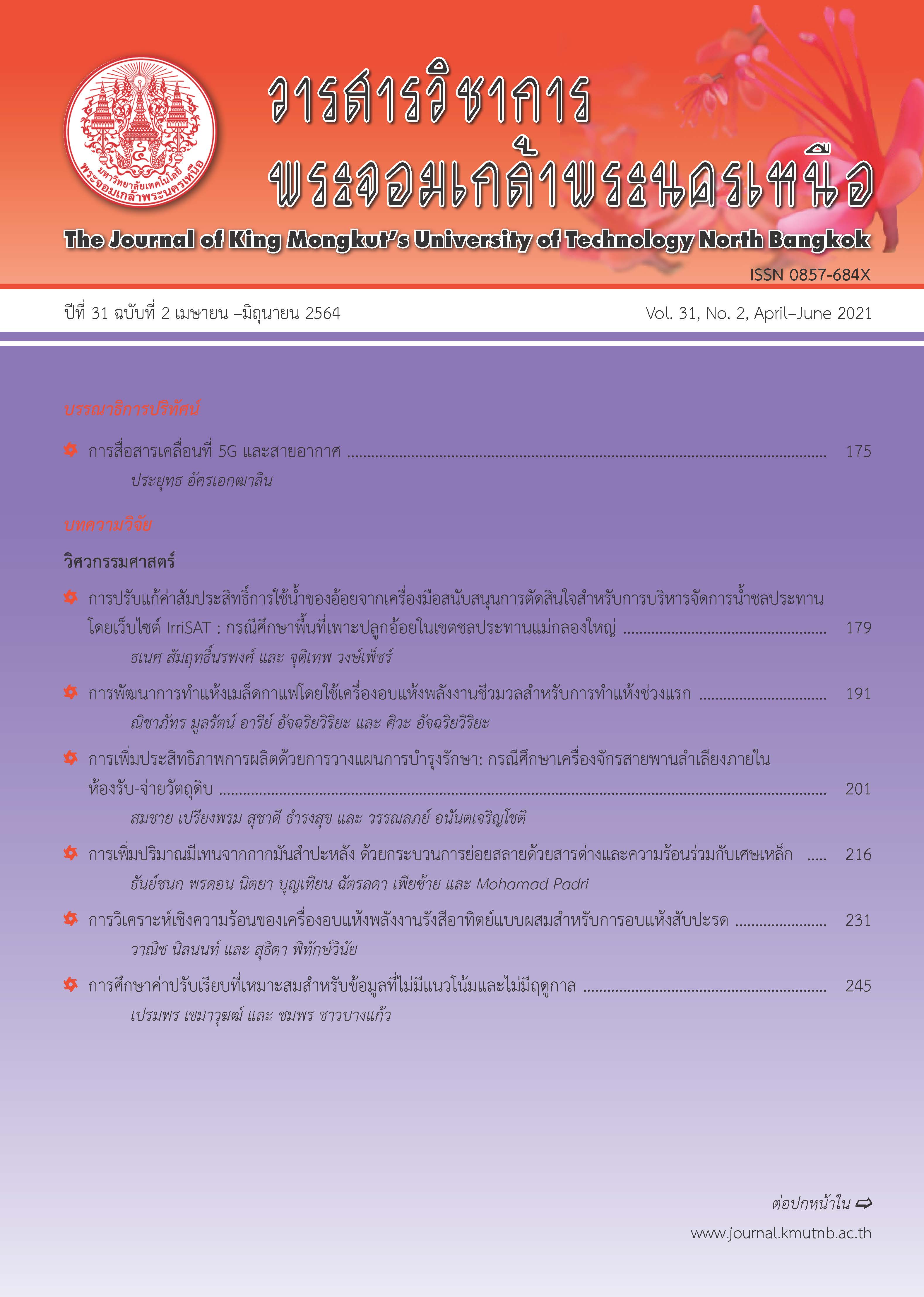แบบแผนการถ่ายทอดทางพันธุกรรมของยีน Salt Inducible Kinase1 (sik1(+/–)) ในปลาม้าลาย (Denio rerio) กลายพันธุ์แบบเฮเทอโรไซกัส
Main Article Content
บทคัดย่อ
ยีน Salt Inducible Kinase1 (sik1) มีบทบาทในเรื่องของการควบคุมสมดุลกลูโคสและไขมันใน Metabolic Pathway และมีความเกี่ยวข้องกับการตกไข่ในปลาม้าลาย การสร้างตัวกลายพันธุ์ที่ถูกดัดแปลงพันธุกรรมโดยใช้เทคนิค CRISPR/Cas9 นั้น อาจทำให้แบบแผนการถ่ายทอดลักษณะทางพันธุกรรมของยีนไม่เป็นไปตามกฎของเมนเดล ในการวิจัยครั้งนี้จึงได้ศึกษารูปแบบการถ่ายทอดทางพันธุกรรมในปลาม้าลายรุ่น F2 ซึ่งได้มาจากการผสมพันธุ์ระหว่างปลาม้าลายรุ่นพ่อแม่ (F1) ที่เป็นตัวกลายพันธุ์แบบเฮเทอโรไซกัส (sik1(+/–)) และไวลด์ไทป์ โดยตรวจสอบรูปแบบการเปลี่ยนแปลงบนสายดีเอ็นเอด้วยเทคนิค Heteroduplex Mobility Assay (HMA) และ Sequencing ผลการศึกษาพบว่า บริเวณดีเอ็นเอเป้าหมายของปลาม้าลายกลายพันธุ์แบบเฮเทอโรไซกัสในร่นุ F2 (sik1(+/–)) มีการเพิ่มของลำดับเบส 12 ตำแหน่ง และการหายไปของลำดับเบส 9 ตำแหน่งส่งผลให้สามารถแปลรหัสเป็นกรดอะมิโนได้เพียง 3 ตำแหน่ง เท่านั้น เช่นเดียวกับปลาม้าลายกลายพันธุ์ในรุ่น F1 (sik1(+/–)) แสดงให้เห็นว่ารหัสพันธุกรรมที่ถูกเปลี่ยนแปลงสามารถถ่ายทอดไปยังรุ่นลูกได้ แต่แบบแผนการถ่ายทอดไม่เป็นไปตามกฎของเมนเดล ซึ่งอาจเป็นไปได้ว่าเมื่อยีน sik1 ถูกดัดแปลงลักษณะทางพันธุกรรมทำให้เสียสมดุลกลูโคสและไขมัน ส่งผลทำให้ปลาที่กลายพันธุ์ตาย หรืออาจเกิดความผิดปกติในช่วงการตกไข่ จึงทำให้สัดส่วนระหว่างตัวที่เป็นไวลด์ไทป์และตัวกลายพันธุ์แบบเฮเทอโรไซกัส (sik1(+/–)) ไม่เป็นไปตามกฎของเมนเดล ดังนั้นงานวิจัยครั้งนี้จึงมีประโยชน์ในการวางแผนเพื่อผลิตจำนวนตัวกลายพันธุ์แบบเฮเทอโรไซกัส (sik1(+/–)) ที่ต้องการสำหรับการศึกษาที่เกี่ยวข้องกับบทบาทของยีน sik1 ในอนาคตต่อไป
Article Details
บทความที่ลงตีพิมพ์เป็นข้อคิดเห็นของผู้เขียนเท่านั้น
ผู้เขียนจะต้องเป็นผู้รับผิดชอบต่อผลทางกฎหมายใดๆ ที่อาจเกิดขึ้นจากบทความนั้น
เอกสารอ้างอิง
[2] J. P. Briggs, “The zebrafish: A new model organism for integrative physiology,” American Journal of Physiology-Regulatory Integrative and Comparative Physiology, vol. 282, no. 1, pp. 3–9, 2002.
[3] W. Driever, D. Stemple, A. Schier, and L. Solnica- Krezel, “Zebrafish: Genetic tools for studying vertebrate development,” Trend in Genetic, vol. 10, pp. 152–159, 1994.
[4] K. Sakamoto, L. Bultot, and O. Göransson, “The salt-inducible kinases: Emerging metabolic regulators,” Trends in Endocrinology and Metabolism, vol. 29, no. 12, pp. 827–840, 2018.
[5] M. Okamoto, H. Takemori, and Y. Katoh, “Salt-inducible kinase in steroidogenesis and adipogenesis,” Trends in Endocrinology and Metabolism, vol. 15, no. 1, pp. 21–6, 2004.
[6] W. Klangnurak, T. Fukuyo, M. D. Rezanujjaman, M. Seki, S. Sugano, Y. Suzuki, and T. Tokumoto, “Candidate gene identification of ovulationinducing genes by RNA sequencing with an in vivo assay in zebrafish,” Plos One, vol. 13, no. 5, pp. 1–19, 2018.
[7] W. Klangnurak and T. Tokumoto, “Fine selection of up-regulated genes during ovulation by in vivo induction of oocyte maturation and ovulation in zebrafish,” Zoological Letters, vol. 3, no. 2, pp. 1–10, 2017.
[8] F. A. Ran, P. D. Hsu, J. Wright, V. Agarwala, D. A. Scott, and F. Zhang, “Genome engineering using the CRISPR-Cas9 system,” Nature America, vol. 8, pp. 2281–2308, 2013.
[9] K. Salman, T. R. Perrino, and R. A. Wallace, “Experimental conditions for oocyte maturation in the zebrafish, Brachydanio rerio,” The Journal of Experimental Zoology, vol. 269, no. 6, pp. 538–550, 1994.
[10] H. P. Tang, Y. Liu, J. Z. Li, G. F. Li, Y. Chen, Y. K. Yin, Y. Guo, C. H. K. Cheng, X. C. Liu, and H. R. Lin, “LH signaling induced ptgs2a expression is required for ovulation in zebrafish,” Molecular and Cellular Endocrinology, vol. 447, pp. 125–133, 2017.
[11] H. P. Tang, Y. Liu, J. Z. Li, Y. K. Yin, G. F. Li, Y. Chen, S. S. Li, Y. Zhang, H. R. Lin, X. C. Liu, and C. H. K. Cheng, “Gene knockout of nuclear progesterone receptor provides insights into the regulation of ovulation by LH signaling in zebrafish,” Scientific Reports, vol. 6, pp. 1–11, 2016.
[12] C. Yu, Y. Zhang, S. Yao, and Y. Wei, “A PCR based protocol for detecting indel mutations induced by TALENs and CRISPR/Cas9 in zebrafish,” PLOS one, vol. 9, no. 6, pp. 1–9, 2014.
[13] M. Westerfield, The Zebrafish Book: A Guide for the Laboratory Use Of Zebrafish (Brachydanio rerio). Eugene: University of Oregon press., 1995.
[14] S. Ansai, K. Inohaya, Y. Yoshiura, M. Schartl, N. Uemura, R. Takahashi, and M. Kinoshita, “Design, evaluation and screening methods for efficient targeted mutagenesis with transcription activator-like effector nucleases in medaka,” Development, Growth Differentiation, vol. 56, no. 1, pp. 98–107, 2014.
[15] A. Kawahara, T. Yabe, S. Ansai, S. Takada, and M. Kinoshita, “Genome editing in zebrafish and medaka “ in Targeted Genome Editing Using Site-Specific Nucleases: ZFNs, T. Yamamoto, Ed., ed Japan: Springer, 2015, pp. 119–131.
[16] L. Jao, S. R. Wente, and W. Chen, “Efficient multiplex biallelic zebrafish genome editing using a CRISPR nuclease system,” in Proceedings of the National Academy of Sciences of the United States of America, 2013, pp. 13904– 13909.
[17] A. R. Bassett, C. Tibbit, C. P. Ponting, and J. Liu, “Highly efficient targeted mutagenesis of drosophila with the CRISPR/Cas9 system,” Cell Reports, vol. 4, no. 11, pp. 220–228, 2013.
[18] H. A. Grunwald, V. M. Gantz, G. Poplawski, X. S. Xu, E. Bier, and K. L. Cooper, “Super-mendelian inheritance mediated by CRISPR-Cas9 in the female mouse germline,” Nature, vol. 566, pp. 105–109, 2019.
[19] N. C. Mishira and E. L. Tatum, “Non-mendelian inheritance of DNA-induced inositol independence in Neurospora,” in Proceedings of the National Academy of Sciences of the United States of America, 1973, pp. 3875–3879.

